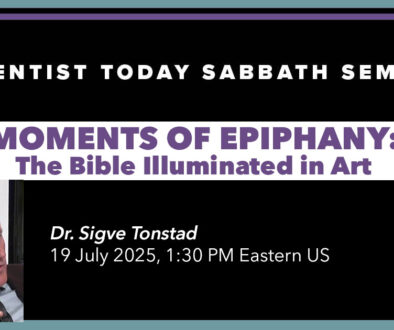Abortion Statement: 2019 General Conference Executive Committee
by Loren Seibold | 18 October 2019 |
I am not an expert on the ethical questions surrounding abortion, or on the history of this issue in the church. What I’m reporting here is what I heard in Monday’s meeting of the General Conference (GC) Excom, followed up, and the final version of the statement approved, at the Wednesday morning meeting. According to Elder Wilson, the Adventist church has never had a comprehensive statement on abortion. You have heard of the 1992 guidelines, but that, said Elder Wilson, was a more limited statement, not a comprehensive one.
The leaders of the discussion were Elias Brasil de Souza, Artur Stele and Peter Landless, who took turns at the microphone.
A young female colleague commented, “If anything should make you realize the church is a gerontocracy, this is it.”
Yet no one has been particularly content with the earlier statement, thus this new statement on the biblical view of unborn life and implications for abortion.
(By the way, I’ve asked others to write on this topic who are more conversant with it than I am. My own feeling is that neither side in the pro-choice, pro-life debate has been particularly pro-family—this is a piece I wrote on it in 2009, though in Spectrum’s archives my name doesn’t appear on it.)
For an excellent and very careful analysis written before the meeting, see Dr. David Larsen’s analysis of the statement. I offer my observations as one who was sitting there listening in the meeting.
What is this, really, and how will it be used?
One of the major things the discussion leaders repeated is this: this is only a statement. It is not part of the Church Manual. It is not a doctrine, or a fundamental belief. It is not intended for church members to use to judge others. It is a statement of how the Bible speaks to us about the value of life.
Yet as one of the European delegates, Audrey Anderson, said, “The further we get from this building, the more the distinction between statement and doctrine gets blurred.”
If you read this statement, you’ll find it reads like a Bible study. While I found no unusual violence to the meaning of Bible passages in it, neither did I find it a creative or challenging exposition. It has in common with many Adventist Bible studies a proof-texting feeling, as though a passage from the Old Testament takes the same hermeneutic as a passage from Paul. And like a lot of Bible-based studies, it lacks nuance for those specific, difficult situations that were mentioned in comments from the floor—things like rape and threats to the life of the mother, those very politicized issues that may be pushing this agenda in the church right now.
What kind of hermeneutic have you used in preparation of this document? Dr. Stele was asked. He replied that as a church we are committed to the authority of scripture. We make no appeal to natural law, ethical theory, or theoretical speculation. (Can you avoid them? I wondered) The Bible tells us how it should be interpreted. He invoked a “Methods of Bible Study” document from 1986.
I’ve read through this last document, and it seems to me that while it is adequate to guide someone to write a Bible study that says that God loves life, it seems inadequate to unpack some of the practical questions that arise at the margins of life—which may be why the statement didn’t do that. Did we really need to again be told that God loves human life, if that helps us not at all to, say, decide between the life of a fetus and the life of the fetus’s mother?
Again, I understand why we may not want to go there, but then what’s the agenda for this statement? The reason for a new statement wasn’t completely clear to me.
Dr. Landless anticipated that some would think this work targeted Adventist healthcare systems. He minimized that fear—though later, Elder Wilson did say this was the first step to a more formal set of guidelines. If I were in Adventist healthcare, I’d be concerned.
What’s the context of this statement?
It seemed to me from the ensuing discussion that some wanted our stand on abortion to be more like that of other fundamentalist Christian churches, and like Roman Catholics. Elder Doug Batchelor specifically mentioned his many evangelical friends who think our lack of a strong stand on abortion is a scandal. Elder Batchelor (echoing far-right abortion opponents) even suggested getting rid of section 6, which talks about “rare and extreme cases,” when “human conception may produce pregnancies with fatal prospects and/or acute, life-threatening birth anomalies that present individuals and couples with exceptional dilemmas. Decisions in such cases may be left to the conscience of the individuals involved and their families,” it says, and adds, “God’s grace promotes and protects life. Individuals in these challenging situations may come to Him in sincerity and find direction, comfort, and peace in the Lord.”
I found section 6 mostly an encouraging paragraph. Yet Elder Batchelor, it seemed to me, gave us his context when he told us he values the views of his right-wing fundamentalist friends more than he embraces God’s grace and sympathy for women and men in the throes of reproductive crisis.
Who prepared it?
We know that Elias Brasil de Souza, Artur Stele and Peter Landless were involved in preparing this statement. Even though the leader mentioned the qualifications that made up the team that wrote the statement, their names weren’t listed. A well-known Adventist medical ethicist, whose name you would recognize, told me he got to read it, but was sidelined from contributing to it in any significant way.
How many writers were women? A young female colleague of mine, when watching this discussion on the live feed, commented, “If anything should make you realize the church is a gerontocracy, this is it—old men rotating to the microphone, talking about what they’ve decided about what women should do with their bodies.” Can you blame her?
How much was this statement informed by other cultures? My impression is that it arises out of an American context, pushed mostly by American conservative Protestantism and its concomitant political goals. My friend Dr. Suranjeen Prasad Pallipamula said in a comment on the floor that in some places in India a third of pregnancies are terminated. Was that part of the consideration when this piece was written? I don’t think so. Listen to his impassioned plea, and how it was met.
Should it deal with rape, incest, and the life of the mother?
When a young woman who said she’d had experience in the matter of rape asked why the document said nothing about it, Artur Stele gave this bizarre answer: “Rape is an act of violence. To suggest to solve an act of violence with another act of violence against the baby contradicts the Biblical principle. So it is very difficult to put it into a Biblical statement.” You can watch it here.
Which absence of practical answers leads one to ask: why this particular statement, and why now? Where does it lead? What did its framers believe the church needed to accomplish with it? Is there a policy or a doctrine waiting behind it? There seem to be potential conflict points here that will drag the church directly into a place in the American political context that I don’t think we want to be.
Not being certain of the context, it’s hard to know why the framers of this document wanted to do it now, and why they stopped where they did. Section 6, on compassion and grace, was welcome. But in the end, glib answers to specific questions, like Dr. Stele’s on rape, are embarrassingly deficient.
Perhaps that was intentional. But here’s my concern: if the church is going to enter this arena, it won’t be able to straddle these big political questions for much longer, particularly if Doug Batchelor and his evangelical friends have their way. Perhaps if the context were bigger than America (as Dr. Suranjeen suggested), we could contribute something bigger, something creative, rather than just jumping into an already polarized American political discussion.
The statement was approved, at just about the last moment when it could be, at the end of the morning session on the last day of the meeting—after many of the participants had already left. I don’t think there’s anything harmful in it, but neither do I see it as especially helpful. It is, in the end, a statement that God loves life—and we’re past the point where that’s the central question people are asking.
You can read the complete statement here.
 Loren Seibold is the Executive Editor of Adventist Today magazine and website.
Loren Seibold is the Executive Editor of Adventist Today magazine and website.




